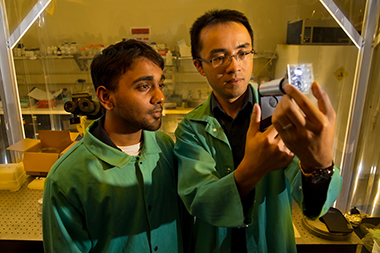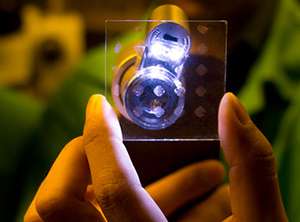A Tiny Answer to a Big Problem
 |
|
Jun Wang (right) and research assistant Justin George ’16. (Photo by Carlo de Jesus)
|
ALBANY, N.Y. (July 25, 2016) – The counterfeit drug industry is thriving. Criminals are cashing in on an estimated $200 billion in profits – nearly 10 percent of pharmaceuticals worldwide – while unknowing consumers put their health or even lives at risk.
Jun Wang has seen the numbers and he’s turning to microtechnology for a solution.
Wang, an assistant chemistry professor, is leading a team of University at Albany researchers in developing microsize QR (microQR) codes that can be used to authenticate medicine, as well as any other product that has potential for counterfeit.
Like any other QR (quick response) code, Wang’s microQR can be scanned by consumers to view item information such as product name, dosage, manufacturing location and batch number. What makes his technology unique is the “micro” component. Roughly the size of a dust particle (10-200 micrometers), the code is undetectable to the naked eye to prevent black market duplication. It’s also edible, meaning it can be attached to a capsule or incorporated into a drug’s formulation.
 |
|
Wang’s microQR code technology (pictured above) is roughly the size of a dust particle. (Photo by Carlo de Jesus)
|
To view the microQR, consumers need a cellphone microscope, available at Amazon.com for around $10. Once the code is detected, it can be scanned to generate the information needed to prove a product’s legitimacy.
“Our technology has strong potential to protect against fake products,” Wang said. “Medicine is an easy target for counterfeiters. By using the wrong active ingredient, or filling incorrect doses, this type of fraud imposes a great danger to patients. We want to help consumers feel secure about what they are purchasing.”
Finding innovative ways to use microtechnology is nothing new for Wang's lab. They’ve been doing so since joining UAlbany’s Forensic Technology Institute in 2014. Typically, the team focuses on applying the technology to disease diagnostics and forensic investigations. Wang said they came up with the idea for product authentication after a few trips to the supermarket.
“We would see these large barcodes at the supermarket all the time. It got us talking about how easily they could duplicated,” Wang said. “At that time, our lab already had the technology in place to ink barcodes in microparticles, so we made it.”
Wang said the team hopes to continue making progress on their microQR technology in upcoming months. Specifically, they’d like to explore the role it can play for large supply chains in tracking product distribution. They’re also looking at other uses for the technology – including the validation of paychecks and identification cards.
To learn more, you can view Wang’s recently published paper in Small. Also meet the group of UAlbany students working in his lab here.
![]() For more news, subscribe to UAlbany's RSS headline feeds
For more news, subscribe to UAlbany's RSS headline feeds
A comprehensive public research university, the University at Albany-SUNY offers more than 120 undergraduate majors and minors and 125 master's, doctoral and graduate certificate programs. UAlbany is a leader among all New York State colleges and universities in such diverse fields as atmospheric and environmental sciences, business, education, public health,health sciences, criminal justice, emergency preparedness, engineering and applied sciences, informatics, public administration, social welfare and sociology, taught by an extensive roster of faculty experts. It also offers expanded academic and research opportunities for students through an affiliation with Albany Law School. With a curriculum enhanced by 600 study-abroad opportunities, UAlbany launches great careers.


